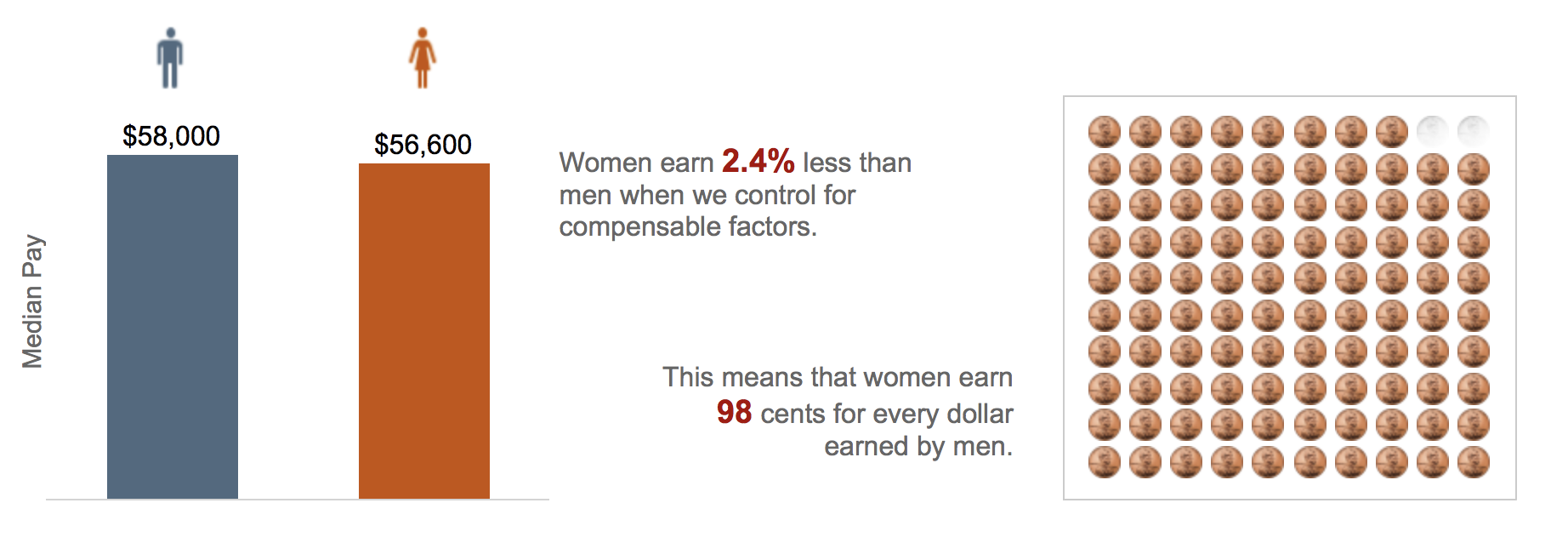[caption id="attachment_138662" align="aligncenter" width="6075"]

Gender Pay Gap[/caption] Viewed in broad scope, just about every study shows that the pay differential between men and women is substantial. New data from PayScale shows that, when we add a bit of context, that gap narrows significantly, and attitudes about it are changing. The 1.8 million people surveyed by PayScale provide a comprehensive look at the salary difference between men and women. PayScale identifies five key factors that affect the wage gap: job type, job level, compensable factors (experience, education, etc.), marriage/family, and unconscious bias. Interestingly, PayScale stated that: “though more men say they prioritize family over work more often, married working mothers have the highest pay gap compared to married working fathers.” An ‘uncontrolled’ comparison is “calculated by comparing the average earnings of all working men to all working women.” That’s where we get those figures showing that women make 77 cents on the dollar compared to men. A more direct comparison, or ‘controlled’ view, shows the pay gap isn’t quite as great. When viewed as “similar men and women in similar jobs,” PayScale data shows the gap at 2.7 percent in its
2015 survey: the same $60,200 for men, and $58,600 for women. [caption id="attachment_138661" align="aligncenter" width="1844"]

2016 Gender Pay Gap From PayScale[/caption]
Changing Attitudes About Gender and Pay
The study shows that some of the more ‘common’ jobs held by men have titles such as ‘engineer’ and ‘manager.’ Women tend to have jobs with titles that include terms such as ‘assistant,’ ‘aide’ and ‘support.’ Similarly, the number of states with women in lower-paying jobs (under $40,000) compared to men is wildly skewed; 26 to one. When you compare the number of states paying $60,000 or better, there are 37 states with well-paid men, compared to seven where women report that same salary level. And there are signs that change is coming. PayScale
reports the gender gap has narrowed by 0.3 percent in its most recent study (down to 2.4 percent), while noting that over 50 percent of those polled cite gender inequality as a problem in their workplace. Furthermore, the report finds “not just women, but also men, who believed their employer was not addressing gender inequity reported being less satisfied at work and more likely to be seeking a new job.” The downside? Those surveyed report lower pay in 2016 versus last year: $58,000 for men and $56,600 for women. “Equitable pay and promotion practices are not just good for employees, they can also have a serious impact on talent retention for both genders,” said Lydia Frank, Vice President of Content Strategy at PayScale. “This research indicates that employees want to work for an organization that shares their same values. However, employers must also communicate their commitment to fairness to their workers. Taking appropriate action to ensure gender equity around pay, hiring practices, and promotion opportunities is crucial, but if employees don’t know you’re taking action, it can be as harmful as taking no action at all.” Even at 2.4 percent, any gender pay gap is a problem. The good news is more people are aware of it, and care about eliminating the divide.
 Gender Pay Gap[/caption] Viewed in broad scope, just about every study shows that the pay differential between men and women is substantial. New data from PayScale shows that, when we add a bit of context, that gap narrows significantly, and attitudes about it are changing. The 1.8 million people surveyed by PayScale provide a comprehensive look at the salary difference between men and women. PayScale identifies five key factors that affect the wage gap: job type, job level, compensable factors (experience, education, etc.), marriage/family, and unconscious bias. Interestingly, PayScale stated that: “though more men say they prioritize family over work more often, married working mothers have the highest pay gap compared to married working fathers.” An ‘uncontrolled’ comparison is “calculated by comparing the average earnings of all working men to all working women.” That’s where we get those figures showing that women make 77 cents on the dollar compared to men. A more direct comparison, or ‘controlled’ view, shows the pay gap isn’t quite as great. When viewed as “similar men and women in similar jobs,” PayScale data shows the gap at 2.7 percent in its 2015 survey: the same $60,200 for men, and $58,600 for women. [caption id="attachment_138661" align="aligncenter" width="1844"]
Gender Pay Gap[/caption] Viewed in broad scope, just about every study shows that the pay differential between men and women is substantial. New data from PayScale shows that, when we add a bit of context, that gap narrows significantly, and attitudes about it are changing. The 1.8 million people surveyed by PayScale provide a comprehensive look at the salary difference between men and women. PayScale identifies five key factors that affect the wage gap: job type, job level, compensable factors (experience, education, etc.), marriage/family, and unconscious bias. Interestingly, PayScale stated that: “though more men say they prioritize family over work more often, married working mothers have the highest pay gap compared to married working fathers.” An ‘uncontrolled’ comparison is “calculated by comparing the average earnings of all working men to all working women.” That’s where we get those figures showing that women make 77 cents on the dollar compared to men. A more direct comparison, or ‘controlled’ view, shows the pay gap isn’t quite as great. When viewed as “similar men and women in similar jobs,” PayScale data shows the gap at 2.7 percent in its 2015 survey: the same $60,200 for men, and $58,600 for women. [caption id="attachment_138661" align="aligncenter" width="1844"]  2016 Gender Pay Gap From PayScale[/caption]
2016 Gender Pay Gap From PayScale[/caption]


